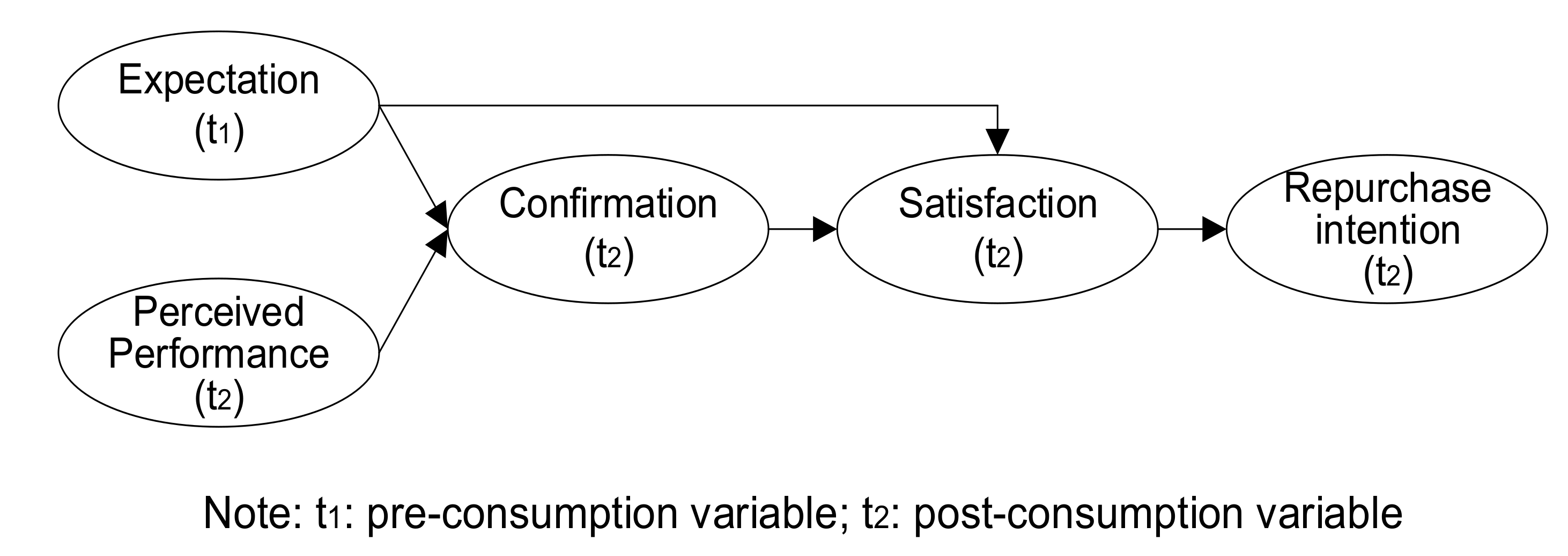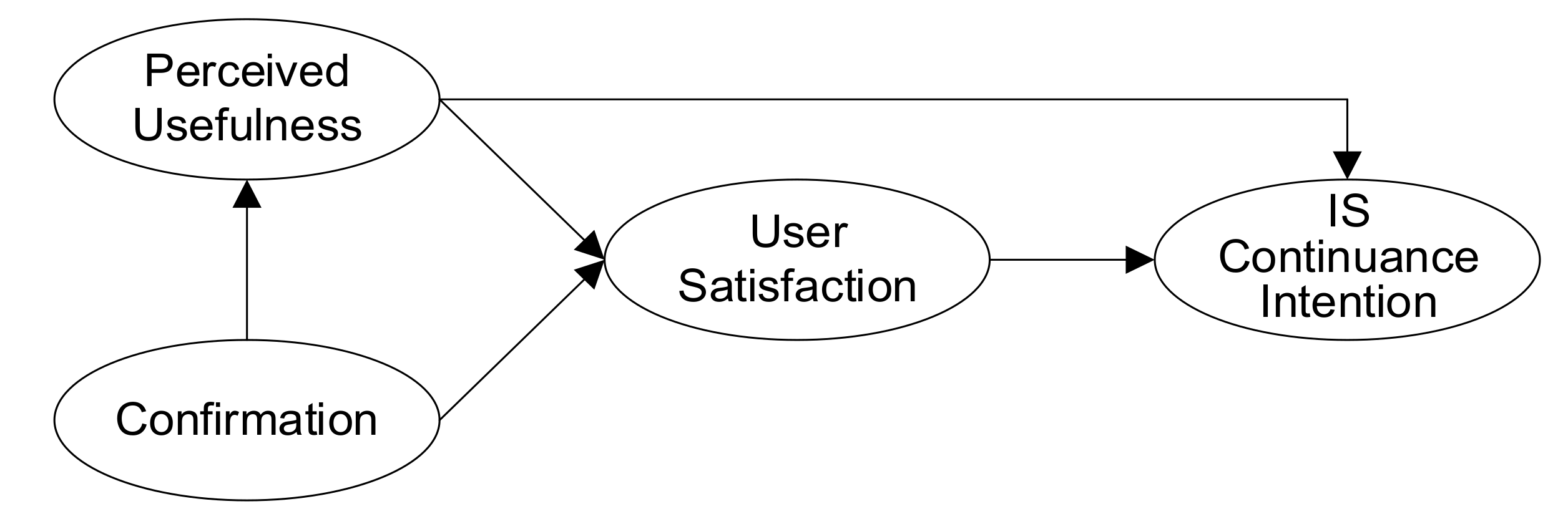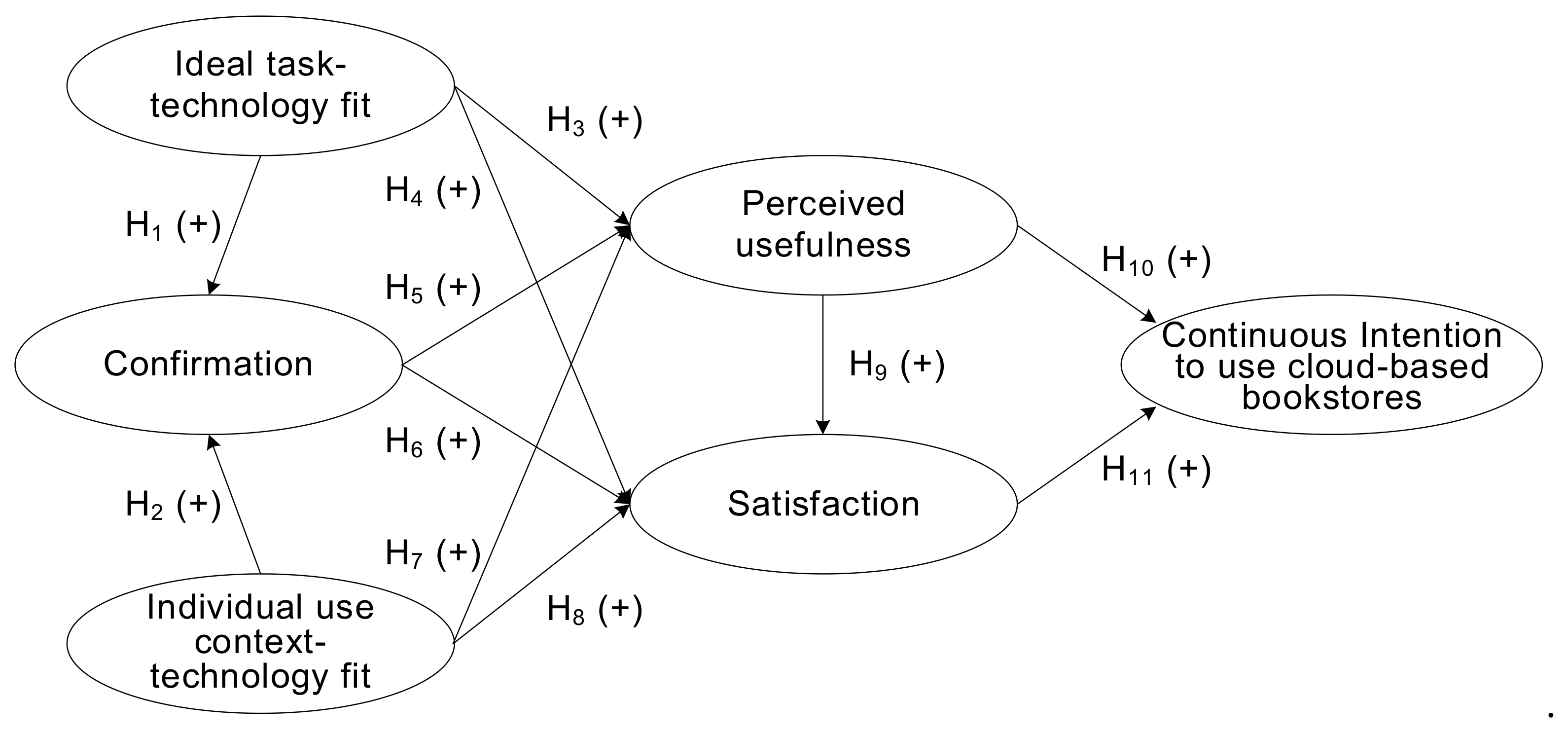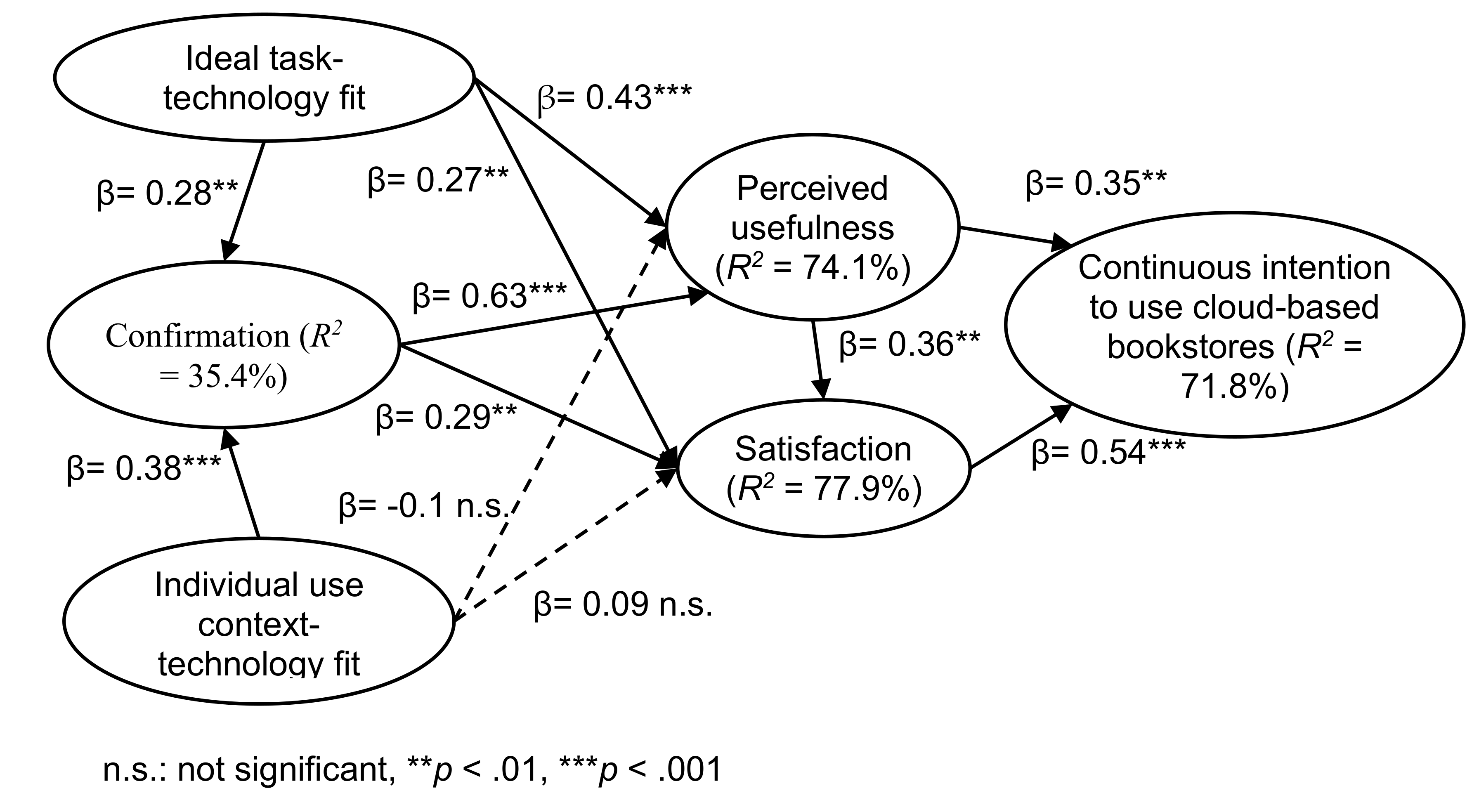Exploring Cloud-Based Bookstore Continuance from a Deconstructed Task–Technology Fit Perspective
Abstract
1. Introduction
2. Literature Review
2.1. Cloud-Based Bookstores
2.2. Continuous Use of Information Systems
2.3. Task–Technology Fit Theory
2.4. Deconstructed Task–Technology Fit Theory
3. Research Model and Hypotheses
3.1. Conceptual Model Formulation
3.2. The Influence of Ideal Task–Technology Fit and Individual Use Context–Technology Fit on Expectation Confirmation
3.3. The Influence of Ideal Task–Technology Fit and Individual Use Context–Technology Fit on Perceived Usefulness
3.4. The Influence of Ideal Task–Technology Fit and Individual Use Context–Technology Fit on Satisfaction
3.5. The Influence of Expectation Confirmation on Perceived Usefulness and Satisfaction
3.6. The Influence of Perceived Usefulness on Satisfaction
3.7. The Influence of Perceived Usefulness and Satisfaction on Continuous Intention
4. Methodology
4.1. Instrument Development
4.2. Sample and Data Collection
5. Results
5.1. Demographic Information
5.2. Exploratory Factor Analysis
5.3. Measurement Model
5.4. Structural Model
6. Discussion
6.1. General Discussion
6.2. Implications
6.3. Limitations
7. Conclusion
Author Contributions
Funding
Acknowledgments
Conflicts of Interest
Ethics Statements
References
- Lee, S. An integrated adoption model for e-books in a mobile environment: Evidence from South Korea. Telemat. Inform. 2013, 30, 165–176. [Google Scholar] [CrossRef]
- Hua, G.; Cheng, T.C.E.; Wang, S. Electronic books: To “E” or not to “E”? A strategic analysis of distribution channel choices of publishers. Int. J. Prod. Econ. 2011, 129, 338–346. [Google Scholar] [CrossRef]
- Statista. Digital Media Market Report. Retrieved 11 April 2018. Available online: https://www.statista.com/outlook/213/100/ebooks/worldwide# (accessed on 15 September 2020).
- D’ambra, J.; Wilson-Concepción, S.; Akter, S. Application of the task-technology fit model to structure and evaluate the adoption of E-books by Academics. J. Am. Soc. Inf. Sci. Technol. 2012, 6, 48–64. [Google Scholar] [CrossRef]
- Aldunate, R.; Nussbaum, M. Teacher adoption of technology. Comput. Hum. Behav. 2013, 29, 519–524. [Google Scholar] [CrossRef]
- Mulholland, E.; Bates, J. Use and Perceptions of E-books by Academic Staff in Further Education. J. Acad. Librariansh. 2014, 40, 492–499. [Google Scholar] [CrossRef]
- Maduku, D.K. Understanding E-Book Continuance Intention: Empirical Evidence from E-Book Users in a Developing Country. Cyberpsychol. Behav. Soc. Netw. 2016, 20, 30–36. [Google Scholar] [CrossRef] [PubMed]
- Mafunda, B.; Bere, A.; Swart, J. Establishing Determinants of Electronic Books Utilisation: An Integration of Two Human Computer Interaction Adoption Frameworks. In Proceedings of the the Human-Computer Interaction, Novel User Experiences, Toronto, ON, Canada, 17–22 July 2016. [Google Scholar]
- Sehn, T.C.M.; Fragoso, S. The synergy between eBooks and printed books in Brazil. Online Inf. Rev. 2015, 39, 401–415. [Google Scholar] [CrossRef]
- Cheng, Y.M. Why do users intend to continue using the digital library? An integrated perspective. Aslib J. Inf. Manag. 2014, 66, 640–662. [Google Scholar] [CrossRef]
- Hsiao, K.L.; Chen, C.-C. Value-based adoption of e-book subscription services: The roles of environmental concerns and reading habits. Telemat. Inform. 2017, 34, 434–448. [Google Scholar] [CrossRef]
- Wang, L.; von Laszewski, G.; Younge, A.; He, X.; Kunze, M.; Tao, J.; Fu, C. Cloud Computing: A Perspective Study. New Gener. Comput. 2010, 28, 137–146. [Google Scholar] [CrossRef]
- Lin, A.; Chen, N.-C. Cloud computing as an innovation: Percepetion, attitude, and adoption. Int. J. Inf. Manag. 2012, 32, 533–540. [Google Scholar] [CrossRef]
- Hayes, B. Cloud computing. Commun. ACM 2008, 51, 9–11. [Google Scholar] [CrossRef]
- Ercan, T. Effective use of cloud computing in educational institutions. Procedia Soc. Behav. Sci. 2010, 2, 938–942. [Google Scholar] [CrossRef]
- Dishaw, M.T.; Strong, D.M. Extending the technology acceptance model with task-technology fit constructs. Inform. Manag. 1999, 36, 9–21. [Google Scholar] [CrossRef]
- Saprikis, V.; Markos, A.; Zarmpou, T.; Vlachopoulou, M. Mobile shopping consumers’ behavior: An exploratory study and review. J. Theor. Appl. Electron. Commer. Res. 2018, 13, 71–90. [Google Scholar] [CrossRef]
- Davis, F.D.; Bagozzi, R.P.; Warshaw, P.R. User Acceptance of Computer Technology: A Comparison of Two Theoretical Models. Manag. Sci. 1989, 35, 982–1003. [Google Scholar] [CrossRef]
- Goodhue, D.L. Development and measurement validity of a task-technology fit instrument for user evaluations of information systems. Decis. Sci. 1998, 29, 105–138. [Google Scholar] [CrossRef]
- Lu, H.-P.; Yang, Y.-W. Toward an understanding of the behavioral intention to use a social networking site: An extension of task-technology fit to social-technology fit. Comput. Hum. Behav. 2014, 34, 323–332. [Google Scholar] [CrossRef]
- Oliver, R.L. A Cognitive Model of the Antecedents and Consequences of Satisfaction Decisions. J. Mark. Res. 1980, 17, 460–469. [Google Scholar] [CrossRef]
- Bhattacherjee, A. Understanding information systems continuance: An expectation-confirmation model. MIS Q. 2001, 25, 351–370. [Google Scholar] [CrossRef]
- Hsieh, T.C.; Chen, S.L.; Hung, M.C. Longitudinal test of ePortfolio continuous use: An empirical study on the change of students’ beliefs. Behav. Inf. Technol. 2015, 34, 838–853. [Google Scholar] [CrossRef]
- Hung, M.C.; Chang, I.C.; Hwang, H.G. Exploring academic teachers’ continuance toward the web-based learning system: The role of causal attributions. Comput. Educ. 2011, 57, 1530–1543. [Google Scholar] [CrossRef]
- Soliman, W.; Tuunainen, V.K. Understanding continued use of crowdsourcing systems: An interpretive study. J. Theor. Appl. Electron. Commer. Res. 2015, 10, 1–18. [Google Scholar] [CrossRef]
- Yoo, S.J.; Han, S.H.; Huang, W. The roles of intrinsic motivators and extrinsic motivators in promoting e-learning in the workplace: A case from South Korea. Comput. Hum. Behav. 2012, 28, 942–950. [Google Scholar] [CrossRef]
- Chiu, C.M.; Wang, E.T.G. Understanding Web-based learning continuance intention: The role of subjective task value. Inf. Manag. 2008, 45, 194–201. [Google Scholar] [CrossRef]
- Goodhue, D.L.; Thompson, R.L. Task-Technology Fit and Individual-Performance. MIS Q. 1995, 19, 213–236. [Google Scholar] [CrossRef]
- Yen, D.C.; Wu, C.S.; Cheng, F.F.; Huang, Y.W. Determinants of users’ intention to adopt wireless technology: An empirical study by integrating TTF with TAM. Comput. Hum. Behav. 2010, 26, 906–915. [Google Scholar] [CrossRef]
- Zigurs, I.; Buckland, B.K. A theory of task/technology fit and group support systems effectiveness. MIS Q. 1998, 22, 313–334. [Google Scholar] [CrossRef]
- Hackman, J.R. Toward understanding the role of tasks in behavioral research. Acta Psychol. 1969, 31, 97–128. [Google Scholar] [CrossRef]
- Campbell, D.J. Task complexity: A review and analysis. Acad. Manag. Rev. 1988, 13, 40–52. [Google Scholar] [CrossRef]
- Drazin, R.; van de Ven, A.H. Alternative forms of fit in contingency theory. Adm. Sci. Q. 1985, 30, 514–539. [Google Scholar] [CrossRef]
- Venkatraman, N. The concept of fit in strategy research: Toward verbal and statistical correspondence. Acad. Manag. Rev. 1989, 14, 423–444. [Google Scholar] [CrossRef]
- Nidumolu, S.R. A comparison of the structural contingency and risk-based perspectives on coordination in software-development projects. J. Manag. Inf. Syst. 1996, 13, 77–113. [Google Scholar] [CrossRef]
- Daft, R.L.; Lengel, R.H. Organizational information requirements, media richness and structural design. Manag. Sci. 1986, 32, 554–571. [Google Scholar] [CrossRef]
- Siau, K.; Lim, E.P.; Shen, Z. Mobile commerce: Promises, challenges and research agenda. J. Datab. Manag. 2001, 12, 4–13. [Google Scholar] [CrossRef]
- Mccullough, M. Digital Ground: Architecture, Pervasive Computing, and Environmental Knowing; MIT Press: Cambridge, MA, USA, 2004. [Google Scholar]
- Gebauer, J.; Shaw, M.J.; Gribbins, M.L. Task-technology fit for mobile information systems. J. Inf. Technol. 2010, 25, 259–272. [Google Scholar] [CrossRef]
- Dourish, P. Where the Action Is: The Foundations of Embodied Interaction; MIT Press: Cambridge, MA, USA, 2004. [Google Scholar]
- Gebauer, J.; Ginsburg, M. Exploring the black box of task-technology fit. Commun. ACM 2009, 52, 130–135. [Google Scholar] [CrossRef]
- Lin, W.S. Perceived fit and satisfaction on web learning performance: IS continuance intention and task-technology fit perspectives. Int. J. Hum. Comput. Stud. 2012, 70, 498–507. [Google Scholar] [CrossRef]
- Staples, D.S.; Wong, I.; Seddon, P.B. Having expectations of information systems benefits that match received benefits: Does it really matter? Inf. Manag. 2002, 40, 115–131. [Google Scholar] [CrossRef]
- Parkes, A. The effect of task–individual–technology fit on user attitude and performance: An experimental investigation. Decis. Support Syst. 2013, 54, 997–1009. [Google Scholar] [CrossRef]
- Larsen, T.J.; Sørebø, A.M. The role of task-technology fit as users’ motivation to continue information system use. Comput. Hum. Behav. 2009, 25, 778–784. [Google Scholar] [CrossRef]
- Jarupathirun, S. Exploring the influence of perceptual factors in the success of web-based spatial DSS. Decis. Support Syst. 2007, 43, 933–951. [Google Scholar] [CrossRef]
- Lin, W.S.; Wang, C.H. Antecedences to continued intentions of adopting e-learning system in blended learning instruction: A contingency framework based on models of information system success and task-technology fit. Comput. Educ. 2012, 58, 88–99. [Google Scholar] [CrossRef]
- Stone, R.W.; Baker-Eveleth, L. Students’ expectation, confirmation, and continuance intention to use electronic textbooks. Comput. Hum. Behav. 2013, 29, 984–990. [Google Scholar] [CrossRef]
- Jin, C.H. Adoption of e-book among college students: The perspective of an integrated TAM. Comput. Hum. Behav. 2014, 41, 471–477. [Google Scholar] [CrossRef]
- Vijay, T.S.; Prashar, S.; Sahay, V. The Influence of Online Shopping Values and Web Atmospheric Cues on E-Loyalty: Mediating Role of E-Satisfaction. J. Theor. Appl. Electron. Commer. Res. 2019, 14, 1–15. [Google Scholar]
- Anderson, R.; Swaminathan, S. Customer Satisfaction and Loyalty in E-Markets: A PLS Path Modeling Approach. J. Mark. Theory Pract. 2011, 19, 221–234. [Google Scholar] [CrossRef]
- Choi, N. Information systems satisfaction, loyalty and attachment: Conceptual and empirical differentiation. Behav. Inf. Technol. 2015, 34, 261–272. [Google Scholar] [CrossRef]
- Churchill, G.A., Jr. A Paradigm for Developing Better Measures of Marketing Constructs. J. Mark. Res. 1979, 16, 64–73. [Google Scholar] [CrossRef]
- Straub, D.W. Validating Instruments in MIS Research. MIS Q. 1989, 13, 147–169. [Google Scholar] [CrossRef]
- Hair, J.F.; Black, W.C.; Babin, B.J.; Anderson, R.E. Multivariate Data Analysis: Pearson New International Edition, 7th ed.; Pearson Education Limited: Essex, UK, 2014. [Google Scholar]
- R Core Team. R: A Language and Environment for Statistical Computing; R Foundation for Statistical Computing: Vienna, Austria, 2013. [Google Scholar]
- Rosseel, Y. lavaan: An R Package for Structural Equation Modeling. J. Stat. Softw. 2012, 48, 1–36. [Google Scholar] [CrossRef]
- Fornell, C.; Larcker, D.F. Evaluating Structural Equation Models with Unobservable Variables and Measurement Error. J. Mark. Res. 1981, 18, 39–50. [Google Scholar] [CrossRef]
- Kline, R.B. Principles and Practice of Structural Equation Modeling, 3rd ed.; The Guilford Press: New York, NY, USA, 2011. [Google Scholar]
- Cohen, J. Statistical Power Analysis for the Behavioral Sciences; Academic Press: New York, NY, USA, 2013. [Google Scholar]
- Zhang, X.; Savalei, V. Examining the effect of missing data on RMSEA and CFI under normal theory full-information maximum likelihood. Struct. Equ. Model. Multidiscip. J. 2020, 27, 219–239. [Google Scholar] [CrossRef]
- Ye, J.Q. eBook Business Model. Retrieved 8 April 2018. Available online: http://edm.itri.org.tw/enews/epaper/9912/d01.htm (accessed on 12 September 2020).
- Goodhue, D.L. Understanding user evaluations of information systems. Manag. Sci. 1995, 41, 1827–1844. [Google Scholar] [CrossRef]
- Aljukhadar, M.; Senecal, S.; Nantel, J. Is more always better? Investigating the task-technology fit theory in an online user context. Inf. Manag. 2014, 51, 391–397. [Google Scholar] [CrossRef]
- Omotayo, F.O.; Haliru, A. Perception of task-technology fit of digital library among undergraduates in selected universities in Nigeria. J. Acad. Librariansh. 2020, 46, 102097. [Google Scholar] [CrossRef]





| Construct | Operational Definitions |
|---|---|
| Ideal task–technology fit [39] | The degree of correspondence between teachers’ task requirements and cloud-based bookstores. |
| Individual use context–technology fit [39] | The degree of teachers’ awareness of the correspondence between the anticipation of cloud-based bookstores usage and how it matches their work context (stable/unstable user location). |
| Confirmation [22] | The teachers’ awareness exists of the correspondence between the anticipation of cloud-based bookstores usage and how it matches actual performance. |
| Perceived usefulness [22] | The extent of the teachers’ belief that using cloud-based bookstores would benefit their job performance. |
| Satisfaction [42] | Satisfaction is an evaluation of emotion that the teachers’ experience of using cloud-based bookstores was as pleasurable as expected. |
| Continuous intention to use cloud-based bookstores [42] | The teacher’s intention to continue using cloud-based bookstores. |
| Dimensions | Items |
|---|---|
| Ideal task–technology fit [39] | As far as the reading support of e-books is concerned, I think the function of cloud-based bookstores is corresponding. |
| As far as the trading activity of e-books is concerned, I think the function of cloud-based bookstores is corresponding. | |
| As far as the bookshelf management of e-books is concerned, I think the function of cloud-based bookstores is corresponding. | |
| As far as the support of coherent objects is concerned, I think the function of cloud-based bookstores is corresponding. | |
| As far as the support of time-efficient objects is concerned, I think the function of cloud-based bookstores is corresponding. | |
| Individual use context–technology fit [39] | Upon the dynamic change of user location, I think the interaction ability of cloud-based bookstores is conforming to the demand. |
| Upon the dynamic change of user location, I think the user interface of cloud-based bookstores is conforming to the demand | |
| Upon the dynamic change of user location, I think the adaptive capacity of cloud-based bookstores is conforming to the demand. | |
| Confirmation [22] | My experience of using cloud-based bookstores is better than what I expected. |
| The service provided by cloud-based bookstores is better than what I expected. | |
| Generally speaking, most of my expectations to the cloud-based bookstores are confirmed. | |
| Perceived usefulness [22] | The use of cloud-based bookstores improves my performance in searching for or reading e-books. |
| The use of cloud-based bookstores enhances my convenience in e-book trading. | |
| The use of cloud-based bookstores promotes my benefit in searching or reading e-books. | |
| Generally speaking, cloud-based bookstores are useful. | |
| Satisfaction [42] | I am very satisfied with the convenience of looking for e-books in cloud-based bookstores. |
| I am very satisfied with the diversity of e-books in cloud-based bookstores. | |
| I am very satisfied with the trading mechanism of e-books in cloud-based bookstores. | |
| I am very satisfied with the customized service of cloud-based bookstores. | |
| I am very satisfied with structure of e-book arrangement in cloud-based bookstores. | |
| I am very satisfied with the knowledge communication in cloud-based bookstores. | |
| Continuous intention to use cloud-based bookstores [42] | I prefer to use cloud-based bookstores to search for e-books continuously. |
| I prefer to use cloud-based bookstores to create e-book booklists continuously. | |
| I prefer to use cloud-based bookstores for e-book trading continuously. | |
| In the future, I will utilize the e-book of cloud-based bookstores to prepare course/activity materials. | |
| I think the functions provided by cloud-based bookstores are suitable. | |
| I will recommend other persons to use cloud-based bookstores. | |
| Generally speaking, I prefer to use cloud-based bookstores continuously. |
| Characteristics | Frequency | % | Characteristics | Frequency | % |
|---|---|---|---|---|---|
| Gender | Number of Years of Using Cloud-Based Bookstore | ||||
| Male | 64 | 34.59 | ≤1 | 145 | 78.38 |
| Female | 121 | 65.41 | 2–3 | 31 | 16.76 |
| ≥4 | 9 | 4.86 | |||
| Age | Monthly income | ||||
| ≤30 | 48 | 25.95 | NTD 30,001–40,000 | 18 | 9.73 |
| 31–35 | 57 | 30.81 | NTD 40,001–50,000 | 66 | 35.68 |
| 36–40 | 30 | 16.22 | NTD 50,001–60,000 | 63 | 34.05 |
| 41–45 | 28 | 15.14 | NTD 60,001–70,000 | 20 | 10.81 |
| 46–50 | 12 | 6.48 | ≥NTD 70,001 | 18 | 9.73 |
| ≥51 | 10 | 5.40 | |||
| Educational level | Hours spent in reading e-books per week | ||||
| College degree | 80 | 43.24 | <1 | 149 | 80.54 |
| Graduate degree | 90 | 48.65 | 1–2 | 24 | 12.97 |
| Doctor degree | 15 | 8.11 | 3–4 | 5 | 2.70 |
| ≥5 | 7 | 3.79 | |||
| What functions of cloud-based bookstores are used? (multiple choice) | Most attractive part of cloud-based bookstores? (multiple choice) | ||||
| Purchase e-book | 13 | Powerful function | 18 | ||
| Preview e-book | 103 | High interactivity | 17 | ||
| Download free e-book | 134 | Rich e-book | 47 | ||
| Search e-book | 49 | Without limitation of space and time | 152 | ||
| Other | 5 |
| CIU | SAT | ITTF | PU | EC | IUCTF | |
|---|---|---|---|---|---|---|
| CIU2 | 0.89 | –0.02 | 0.05 | 0.09 | –0.09 | 0.04 |
| CIU5 | 0.84 | –0.02 | 0.06 | 0.00 | 0.04 | –0.01 |
| CIU1 | 0.84 | 0.10 | –0.10 | 0.28 | –0.24 | 0.06 |
| CIU3 | 0.79 | 0.11 | 0.05 | –0.10 | 0.07 | –0.06 |
| CIU6 | 0.75 | –0.08 | 0.09 | 0.03 | 0.21 | –0.05 |
| CIU4 | 0.75 | 0.14 | –0.24 | –0.02 | 0.02 | 0.17 |
| SAT1 | –0.06 | 0.80 | –0.12 | 0.41 | –0.21 | 0.06 |
| SAT2 | –0.12 | 0.75 | 0.01 | 0.23 | 0.03 | 0.05 |
| SAT4 | 0.23 | 0.73 | 0.12 | –0.26 | 0.16 | –0.10 |
| SAT3 | 0.09 | 0.70 | 0.00 | –0.02 | 0.08 | 0.00 |
| SAT6 | 0.09 | 0.67 | 0.04 | 0.10 | 0.06 | –0.04 |
| SAT5 | 0.10 | 0.65 | 0.10 | 0.06 | 0.13 | –0.07 |
| ITTF2 | –0.21 | 0.09 | 0.88 | 0.08 | –0.08 | 0.10 |
| ITTF3 | 0.20 | –0.23 | 0.86 | 0.05 | 0.06 | –0.07 |
| ITTF4 | 0.05 | 0.34 | 0.72 | –0.26 | –0.05 | 0.00 |
| ITTF5 | –0.11 | 0.19 | 0.68 | 0.13 | –0.13 | 0.10 |
| ITTF1 | 0.18 | –0.17 | 0.63 | 0.28 | –0.06 | 0.03 |
| PU1 | 0.16 | 0.13 | –0.04 | 0.73 | –0.07 | 0.04 |
| PU3 | –0.02 | 0.05 | 0.10 | 0.71 | 0.23 | –0.03 |
| PU2 | 0.06 | 0.01 | 0.18 | 0.68 | 0.12 | –0.12 |
| PU4 | 0.05 | 0.10 | 0.02 | 0.59 | 0.31 | –0.06 |
| EC3 | –0.06 | 0.06 | –0.02 | 0.00 | 0.88 | 0.06 |
| EC1 | 0.02 | –0.01 | –0.13 | 0.18 | 0.81 | 0.03 |
| EC2 | 0.02 | 0.05 | –0.04 | 0.15 | 0.77 | 0.07 |
| IUCTF2 | 0.11 | –0.01 | –0.05 | –0.01 | 0.00 | 0.93 |
| IUCTF3 | 0.04 | –0.01 | 0.09 | –0.04 | 0.01 | 0.90 |
| IUCTF1 | –0.07 | –0.04 | 0.18 | –0.06 | 0.19 | 0.79 |
| Eigenvalue | 4.78 | 4.12 | 3.37 | 3.27 | 2.85 | 2.57 |
| Variance Explained | 0.18 | 0.15 | 0.13 | 0.12 | 0.11 | 0.10 |
| Cronbach’s α | 0.94 | 0.92 | 0.88 | 0.91 | 0.90 | 0.93 |
| Constructs | Items | M | SD | Standardized Loading | CR | AVE |
|---|---|---|---|---|---|---|
| Continuous Intention to use cloud-based bookstores (CIU) | CIU1 | 3.46 | 0.90 | 0.87 *** | 0.94 | 0.72 |
| CIU2 | 3.37 | 0.85 | 0.90 *** | |||
| CIU3 | 3.25 | 0.79 | 0.83 *** | |||
| CIU4 | 3.24 | 0.89 | 0.76 *** | |||
| CIU5 | 3.43 | 0.86 | 0.87 *** | |||
| CIU6 | 3.48 | 0.84 | 0.88 *** | |||
| Perceived usefulness (PU) | PU1 | 3.46 | 0.77 | 0.82 *** | 0.91 | 0.73 |
| PU2 | 3.57 | 0.81 | 0.83 *** | |||
| PU3 | 3.66 | 0.76 | 0.90 *** | |||
| PU4 | 3.72 | 0.78 | 0.86 *** | |||
| Satisfaction (SAT) | SAT1 | 3.71 | 0.75 | 0.78 *** | 0.92 | 0.66 |
| SAT2 | 3.70 | 0.73 | 0.82 *** | |||
| SAT3 | 3.43 | 0.70 | 0.76 *** | |||
| SAT4 | 3.43 | 0.75 | 0.81 *** | |||
| SAT5 | 3.45 | 0.71 | 0.87 *** | |||
| SAT6 | 3.56 | 0.74 | 0.82 *** | |||
| Confirmation (EC) | EC1 | 3.34 | 0.79 | 0.84 *** | 0.90 | 0.76 |
| EC2 | 3.37 | 0.80 | 0.94 *** | |||
| EC3 | 3.45 | 0.74 | 0.81 *** | |||
| Ideal task-technology fit (ITTF) | ITTF1 | 3.64 | 0.69 | 0.75 *** | 0.88 | 0.59 |
| ITTF2 | 3.55 | 0.68 | 0.82 *** | |||
| ITTF3 | 3.67 | 0.71 | 0.77 *** | |||
| ITTF4 | 3.44 | 0.74 | 0.75 *** | |||
| ITTF5 | 3.63 | 0.73 | 0.77 *** | |||
| Individual use context-technology fit (IUCTF) | IUCTF1 | 3.39 | 0.77 | 0.85 *** | 0.93 | 0.83 |
| IUCTF2 | 3.41 | 0.78 | 0.92 *** | |||
| IUCTF3 | 3.39 | 0.79 | 0.95 *** |
| M | SD | CIU | PU | SAT | EC | ITTF | IUCTF | |
|---|---|---|---|---|---|---|---|---|
| CIU | 3.37 | 0.75 | 0.85 | |||||
| PU | 3.61 | 0.70 | 0.78 | 0.85 | ||||
| SAT | 3.55 | 0.62 | 0.81 | 0.83 | 0.81 | |||
| EC | 3.39 | 0.71 | 0.75 | 0.79 | 0.76 | 0.87 | ||
| ITTF | 3.59 | 0.58 | 0.65 | 0.69 | 0.73 | 0.53 | 0.77 | |
| IUCTF | 3.40 | 0.73 | 0.59 | 0.52 | 0.61 | 0.56 | 0.66 | 0.91 |
Publisher’s Note: MDPI stays neutral with regard to jurisdictional claims in published maps and institutional affiliations. |
© 2020 by the authors. Licensee MDPI, Basel, Switzerland. This article is an open access article distributed under the terms and conditions of the Creative Commons Attribution (CC BY) license (http://creativecommons.org/licenses/by/4.0/).
Share and Cite
Hung, M.-C.; Talley, P.C.; Kuo, K.-M.; Chiu, M.-L. Exploring Cloud-Based Bookstore Continuance from a Deconstructed Task–Technology Fit Perspective. J. Theor. Appl. Electron. Commer. Res. 2021, 16, 356-376. https://doi.org/10.3390/jtaer16030023
Hung M-C, Talley PC, Kuo K-M, Chiu M-L. Exploring Cloud-Based Bookstore Continuance from a Deconstructed Task–Technology Fit Perspective. Journal of Theoretical and Applied Electronic Commerce Research. 2021; 16(3):356-376. https://doi.org/10.3390/jtaer16030023
Chicago/Turabian StyleHung, Ming-Chien, Paul C. Talley, Kuang-Ming Kuo, and Mai-Lun Chiu. 2021. "Exploring Cloud-Based Bookstore Continuance from a Deconstructed Task–Technology Fit Perspective" Journal of Theoretical and Applied Electronic Commerce Research 16, no. 3: 356-376. https://doi.org/10.3390/jtaer16030023
APA StyleHung, M.-C., Talley, P. C., Kuo, K.-M., & Chiu, M.-L. (2021). Exploring Cloud-Based Bookstore Continuance from a Deconstructed Task–Technology Fit Perspective. Journal of Theoretical and Applied Electronic Commerce Research, 16(3), 356-376. https://doi.org/10.3390/jtaer16030023





